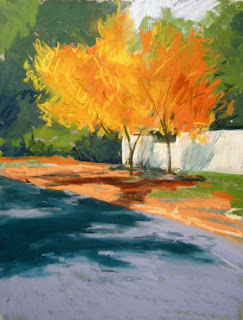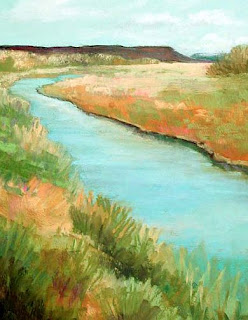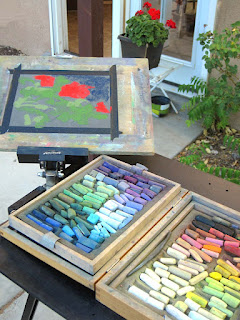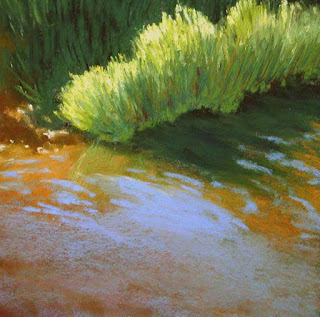 |
| Poblanos Autumn, 12" x 9" |
(With thanks to
The Pastel Journal where this was originally published.)
A man stands at his easel painting the breathtaking vista before him. The sky is bright blue, the day calm and warm. His black umbrella punctuates a field of green and yellow grass near shady cottonwood trees. The mountains are a sweep of cobalt and lavender, topped with crisp white clouds. It looks ideal. No wind. No rain. No bugs. No dust. It’s no wonder painters wish to paint outside on such a glorious day.
But the fact is that it can be uncomfortable painting “en plein air”—meaning on location. Dust does blow, bugs do bite, the sky darkens or the wind blows. It takes planning and energy to drag the easel, pastels and umbrella to the car, drive to a location, lug your gear to a spot, set it up and take it down, then drive home again, usually tired and sometimes unsatisfied with the day’s work.
Working in the studio is usually far less challenging than location work. There, you can control the environment and are able to settle down to work. Lighting conditions remain stable and you can take the time to carefully plan and execute a painting, which can be difficult when working outside. There are no burrs clinging to your socks or stray dogs wandering under your easel, no wind or rain to contend with. Studio work is much less physical, and if nothing comes of the day’s work at least you haven’t spent gas money to do it.
So why do so many painters go through all that to paint outside?
It’s simpler to paint a striking locale from a photograph, yet open-air paintings have a depth and range of color impossible to find in any photograph. Photographs taken at the same time and location look accurate but often are unsatisfying. We’ve come to believe that the color in a photograph is somehow more real, when in fact the interpretation of colors that the artist brings to a painting is far more valid. Shadows are frequently too dark or light areas washed out in a photograph. Paintings made on location have an appealing variety of colors, in shadow or sunlight.
Color is made from light. Painting in the natural sunlight reveals the complexity of the colors all around us. As you look into the shadows you can see details, though they are cooler and darker in value, while the light areas are luminous and glowing. Although most painters prefer to work under the shade of an umbrella or in the solid cast shadow of a building or other object, it’s not impossible to stand in the open sunlight and paint. Light and color go hand in hand. Light is the key to color, which is in turn the key to mood in a painting.
Still, plein air painting takes some getting used to. The almost overwhelming amount of subject matter can result in crowded paintings with no focal area. No piece of paper is adequate to the task of painting the whole world -- or even the western horizon alone. It’s necessary to limit the scope of what you paint on location. Rather than trying to do a painting of the road that leads to the house with the shade trees and flower garden, and the mountains beyond that with the clouds building up to a storm, it’s better to select only parts to paint. Choose the road leading to the house one day. Move closer and paint the garden another day. Then take on the mountains and clouds on a day when they are spectacular.
Even within the context of your chosen subject -- say the mountains and clouds -- use some tried-and-true methods to limit what you paint. Frame the world with your hands or use mat corners to block out portions until you can see clearly what will fit on the paper. Select a visual landmark where you can place your viewfinder, putting the corners in the same position repeatedly so that you can renew acquaintance with your selected bit of the world when needed. Some artists like to look through an empty slide mount. Because you have to close one eye to do this, your field of vision flattens, which sometimes makes it easier to see shapes as interlocking puzzle pieces.
Paintings composed using photographs often look different from those painted outdoors. They contain details that are easily ignored when painting on location, such as the grass directly in front of the easel and the branch overhead that protrudes into the picture plane. The camera lens puts the world out at arm’s length, pushing everything away from the viewer, changing the perspective. The point of view of a plein air painting seems grounded, as though you can sense the easel sitting in the dirt, and extraneous details are easily ignored.
Instead of attempting to complete a painting while on location, it might help to begin by making color and composition sketches on site. When you work quickly and freely you are freed from the desire to paint the perfect finished version of the view. Take along your camera to record details of the place but paint to record your personal response to the colors you see and select the viewpoint and details you want to include. The photographs then become an aid to your personal vision rather than commanding the image. In the studio you can use both photos and sketches to make a finished painting.
Once you discover the pleasure of painting on location and see the merits of color and composition done there, in all likelihood you will be willing to pack your gear and drive out to that special spot or spend time searching out a new one. The delight of seeing and the pleasure of recording your surroundings will begin to outweigh any annoyance and distraction you find there. You probably won’t abandon your studio but you will likely discover that location work strengthens what you do in the studio.
One day you may find yourself standing in a green and yellow field under an umbrella, painting cobalt mountains on a perfect day. No wind. No rain. No bugs. No dust. Then you will know why painters go out on location so often.
 |
| Coronado, 12" x 9" |
________________
Materials for Plein Airlightweight, portable easel
stone sack or empty gallon jug with twine
small palette of pastels (~125 half sticks)
small drawing board, clips, clamps
paper cut to 9x12" or smaller
11x14" newsprint pad with clips OR Clearbags (to transport paintings)
umbrella, clamps
spray bottle (to keep cool)
camera, sketchbook, charcoal, pencils, viewfinder, red filter
wet wipes, paper towels, tape, tools
sunscreen, bug spray, hat OR gloves, scarf, extra socks, jacket
large plastic bags (rain protection, garbage)
cooler, water
folding chair (if watching a demonstration)
 |
| Back yard plein air. |
Many people ask me about my easel and palette setup for plein air. I keep it fairly simple. I use the Anderson Swivel Easel, which works perfectly for my height (5'4"), and an old Rembrandt box filled with half-sticks and smaller bits of pastels that I open and set on top of the easel. I carry most of my supplies in a rolling box. (I have carried things in my backpack, too, but I do that less often now.) I try to keep things simple, lightweight and portable, although I pack a lot into my car so I have it when I need it.
 |
| Painting with mast flat. |
 |
| My well used plein air palette. |
I enjoy the Anderson Swivel Easel because I can swivel the mast around 360 degrees, allowing me to simply turn another direction without rearranging my easel, or lay it down flat and paint looking over it, standing to one side of the easel. (In windy conditions this can be quite helpful.) It's lightweight, only around nine pounds empty. I often cut paper and tape it in place on my board, one piece on top of the next, so that I can start painting the moment I arrive on location. Then I simply remove that piece, slip in into the newsprint pad or a Clearbag to transport without smearing, and I'm ready to begin the next one.
I prefer to do color sketches rather than trying to make a "finished" painting. I record the scene as soon as I'm set up and starting to sketch, taking a photo as I see the view from the easel. I record another shot at the end of the hour (if I paint that long--rarely any longer), so that I have two photos and a color sketch to use in the studio if/when I make a finished painting. However, having freed myself from the mental straitjacket of painting to a finish on location, ironically I'm far more inclined to paint what I consider to be finished work. The three paintings shown here, for instance, were painted entirely on location, with no further work in the studio.
 |
| Corrales Acequia, 9" x 9" |












































